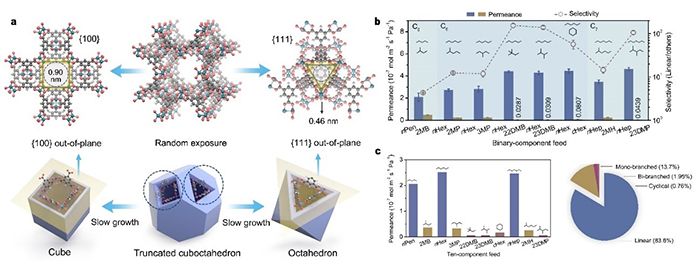In the petrochemical industry, light linear/branched alkane isomers (C5-C7) need to be effectively separated for different end uses, linear alkanes are to be cracked for ethylene production, whereas branched isomers are to be used for gasoline upgrading.
Recently, a research group led by Prof. YANG Weishen and Prof. BAN Yujie from the Dalian Institute of Chemical Physics (DICP) of the Chinese Academy of Sciences (CAS) split linear alkanes from mono-branched and di-branched isomers as well as their cyclical counterparts through oriented metal-organic framework (MOF) membrane.
This study was published in Nature Communications on Oct. 19.
MOFs bring tremendous opportunities for membrane separation. HKUST-1 is an archetypal MOF with a combination of di-nuclear copper paddlewheel units and 1,3,5-benzenetricarboxylic acid to form a face-centered cubic network.
In this study, the researchers indicated that {111}-oriented HKUST-1 membranes were capable of splitting linear alkanes from branched isomers (or cyclical counterparts) by virtue of the size repulsion mechanism, since the rigid triangular pore with a size of ~0.46 nm running through {111} crystal facets was positioned between the kinetic diameters of alkane isomers.

The anisotropy of the porous HKUST-1 architecture and C5-C7 alkane isomer separation through {111}-oriented HKUST-1 membranes at 30°C (Image by BAN Yujie and WANG Yuecheng)
In this study, the {111}-oriented HKUST-1 membranes were formulated according to the morphology-biased principle and finally realized with a low dose synthesis method for terminating undesired crystal nucleation and growth. This membrane could realize one-step extraction of normal-pentane, normal-hexane and normal-heptane from a ten-component alkane isomer solution that mimicked light naphtha.
This work was supported by the National Natural Science Foundation of China and the Youth Innovation Promotion Association of CAS.